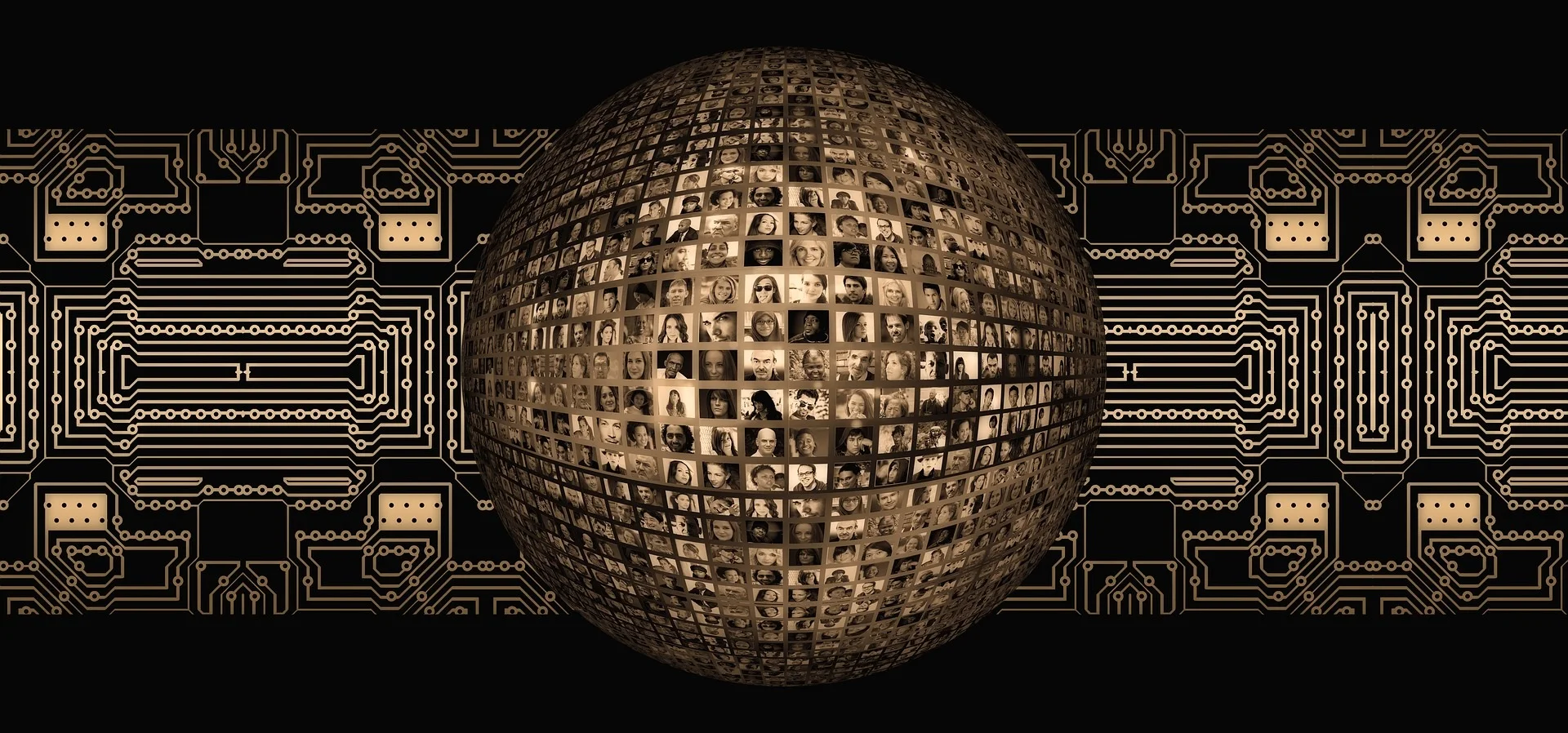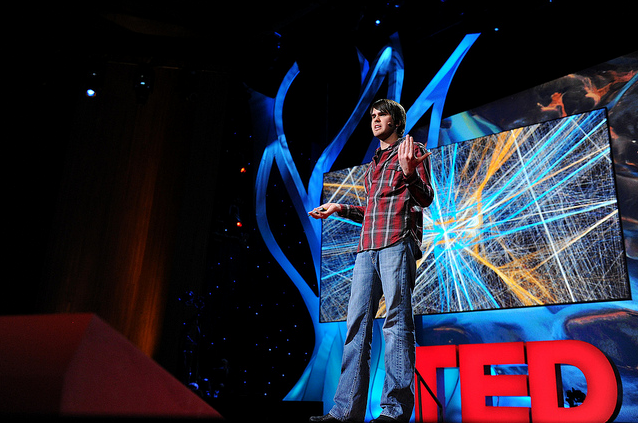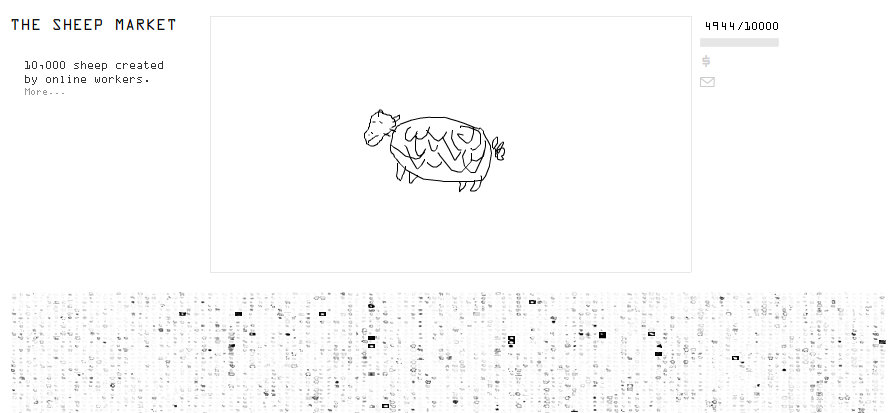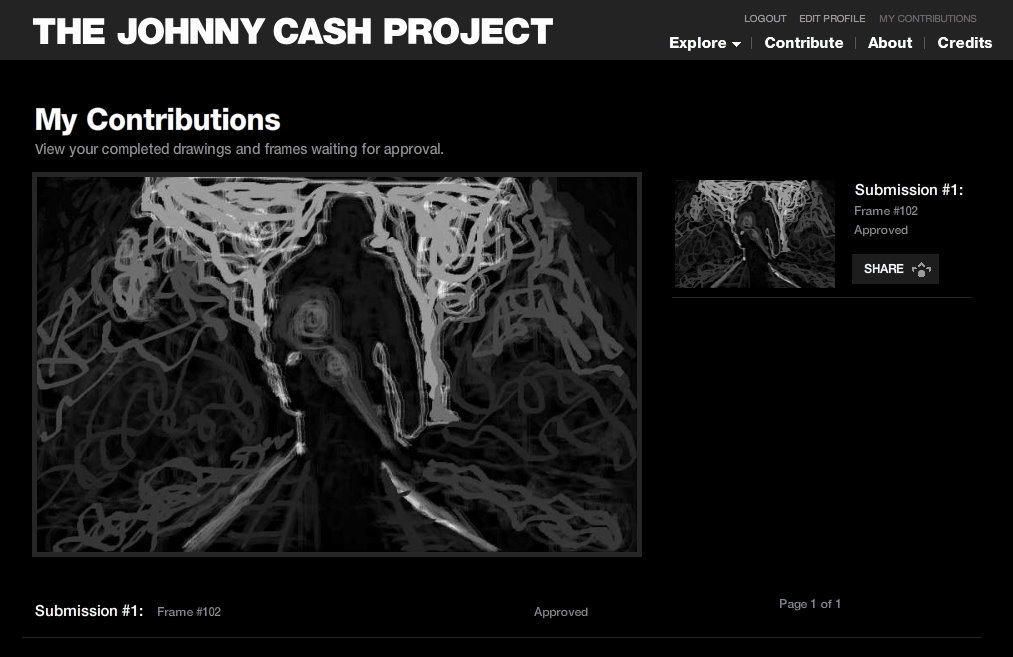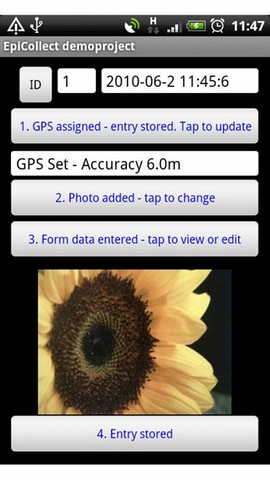As digital crowdsourced art continues as a mode of art making, it is necessary to developed an understanding of which features of digital arts programming are crucial in the engagement of digital audiences. The following analysis of four digital art projects focuses on the participatory, rather than the interactive, specifically projects wherein audiences become artists by participating in the creation of a piece of art by making one or more creative contributions. Perhaps not surprising, agency and control were identified as significant to participation.
Digital Humanities: Library of Congress Labs Opens Collections for Productivity and Play
Archives generally are expected to be places of preservation and documentation, as opposed to innovative research. However, the Library of Congress, America’s oldest archive, just recently unveiled a virtual laboratory space to promote experimental research and creative uses for their aged collections.
Creative Crowdsourcing: How the Smithsonian Turned Data Entry into Engagement
Museum collections, specifically archives, in arts and research institutions are frequently viewed negatively partially because their upkeep is expensive and complicated, taking over precious work-hours for an already overworked staff. The Smithsonian Institution's ongoing operation of a Digital Transcription Center demonstrates that this upkeep can be accomplished in a cost-saving and engaging way.
How Socially Responsible Spending is Replacing Traditional Philanthropy
You would be hard pressed to find any person who has visited a grocery store or movie theater that has not been asked to donate an additional dollar for charity on top of their purchase. It’s become a widely accepted, near expected, practice in contemporary consumer culture. Capitalizing on existing buyer behavior is not just easy- it’s smart. However, the model has advanced far beyond adding a few dollars onto a popcorn purchase at the cinema. It has emerged as a way for organizations to capture financially strapped young donors, and generate creative revenue streams as traditional philanthropic avenues face increased competition.
Redefining Boundaries at the Museum: Crowdsourced Exhibition at the Santa Cruz Museum of Art and History
Since December 19, 2014 the Santa Cruz Museum of Art and History has featured an exhibit of works relating to the ocean, with painting and sculptures by established artists alongside works by local residents. The exhibit includes a wide variety of art, ranging from professional artists’ works to two year-olds’ drawings. Everybody’s Ocean is a partially crowd-sourced and partially curated exhibition presenting everyone’s personal relationship with the sea.
News Summary 10.2014
Every month, AMT Lab publishes a collection of recent arts management and technology news. This month, many articles focused on how the latest technologies, such as 3D printing, can be used to create art. Technology has had a profound impact on cultural industries, and as always we are deeply interested in following these trends.
Research Update: Google for Nonprofit Arts
In today’s culture, Google is seen as one of the most innovative technology companies in the world. From its search engine to the Android operating system, Google has permeated every aspect of our techno-centric lifestyles. Beyond the scope of their technological accomplishments, Google strives to help nonprofit organizations around the world by providing them with free online tools and access to grant monies. Follow the development of this research here.
Technology and Social Media in Crowdsourced Exhibition
In recent years, crowdsourcing has become an increasingly familiar concept implemented by multiple arts organizations to develop and engage audiences. Examples include “Click! A Crowd sourced Exhibition” (Brooklyn Museum, 2008), “Soapbox!” (Museum of Photographic Art, 2013), “Boston Loves Impressionism” (Museum of Fine Art Boston, 2014), and “People Choice”(Gibbes Museum of Art).
Crowd-Sourced Curating at the Brooklyn Museum
As the arts world continues to discuss and reconsider what it means to participate in the arts, the Brooklyn Museum is testing a new construct of audience engagement with its current exhibit GO: A Community-Curated Open Studio Project. GO combines two existing tactics: inviting the public into studios of working artists to see where and how artwork is made, and crowdsourcing the selection of that artwork through an open voting process. Unlike ArtPrize, an art competition in Grand Rapids, MI, that awards cash prizes to artists as determined by public vote (juried awards were added in 2012) and cited by the Brooklyn Museum as inspiration for the current exhibit, GO asks participants to nominate artists—rather than specific pieces—whose work they would like to see exhibited at the museum. The catch is that to be eligible to vote, participants must first visit at least five artist studios, which in turn requires that the museum be able to track where people go. The answer is a multiphase project begun this past September and culminating in an exhibit of Brooklyn artists, on display through February 24.
To participate, the museum first asked individuals to register on the GO community project website. Then, over a two-day open studio event involving nearly 1,800 artists in 46 Brooklyn neighborhoods, participants “checked-in” at each studio visited by way of a unique number displayed onsite. By sending that number to the museum either by text message, a free custom iPhone app, or the web, participants documented where they traveled. Those who checked-in at five or more studios received an email with instructions on how to vote, having earned the opportunity to nominate up to three artists. The museum tallied the results, sent two of its curators to review the work of the top ten nominated artists, and selected five to exhibit.
But GO didn’t stop when the voting was done. By asking participants to check-in, the museum was able to analyze how many people went where, when, and what platform they used to check-in, all of which was then shared in a series of posts on both the GO blog and through the Statistics section of the GO website. (Among those findings: Despite multiple mobile-friendly options designed especially for the event, nearly half of the 6,100+ participants chose to simply write down studio numbers throughout the day and check-in via the project website once back home, surprising project coordinators.) The website also provided a forum for participants to discuss (in real time and afterward) what they did and did not like about the process, share stories from their studio visits, learn about nominated artists, receive updates on the creation of the exhibit, and provide reactions to the final exhibit itself.
The exhibit has been criticized by some for not aptly representing the rich artistic quality Brooklyn holds, and is generating commentary on the age-old curatorial question of who should decide what constitutes “good” art. While a worthwhile debate, it seems to belie the larger point of the project: to expose people to the creative process, and ideally, to facilitate a better understanding of it. On that score, GO appears to have succeeded mightily. As project coordinators tagged entries in the Shared Stories section of the website, one of the most frequent themes to emerge was that of discovery. It seems that by opening studio doors, inviting people to participate in the curatorial process, and sharing reactions online, GO fostered meaningful interactions among artists, voters, volunteers, and museum staff, and in the process, created an innovative approach to engage audiences in the arts.
Looking at the Land: The Crowdsourced, Digital Exhibition from Flak Photo’s Andy Adams
He needs no introduction, but for new visitors to our site it is my pleasure to welcome back Andy Adams to Technology in the Arts.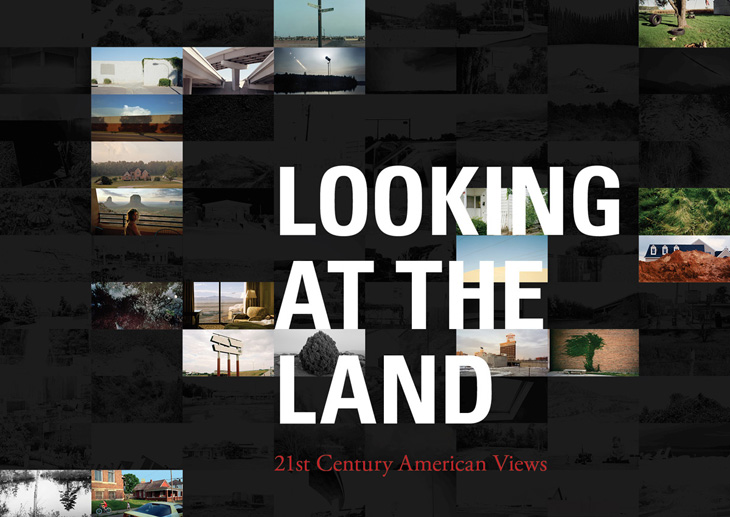 You may remember our conversation with Andy in May when we discussed the concept of Photo 2.0 and the role of Web 2.0 technologies in redefining the field of photography.
You may remember our conversation with Andy in May when we discussed the concept of Photo 2.0 and the role of Web 2.0 technologies in redefining the field of photography.
Andy’s newest success, “Looking at the Land: 21st Century American Views,” is a digital exhibition of 21st Century American Landscape photography. The exhibition, prepared in collaboration with the Museum of Art, Rhode Island School of Design, is a discussion (both in photographs and in interviews) with eighty-eight photographers on the practice and meaning of landscape photo-making in the 21st Century. On the website, Andy discusses the current status of the exhibition, including the presentation of twenty of the photographs in physical form at the FotoWeek DC 2012 festival.
Andy and I again had the chance to discuss the themes of photography and online-presenting, but this time focused on the process of organizing a digital exhibition, his experience with crowdsourcing creativity, and his thoughts on the effects of digital projection on viewing. While my full interview with Andy will be posted here on Technology in the Arts soon, I encourage you to view the online exhibition beforehand (available for viewing below).
[embed]http://vimeo.com/49855891[/embed]
Check back in next two weeks for more of Andy’s insight on the future of photography, digital exhibitions, and crowdsourcing creativity.
American Association of Museums Trend Watch 2012
The American Association of Museums recently published a report titled Trends Watch 2012, Museums and the Pulse of the Future. According to AAM, the field of museology could beat to the rhythm of seven emergent practices in upcoming years. Namely, these are crowdsourcing, alternative social enterprises, public engagement, microgiving or crowdfunding, changing demographics, augmented reality, and new educational opportunities. Of these trends, crowdsourcing, crowdfunding, and augmented reality will be explored in detail as technology fuels their very existence while the arts nourish their popularity. Crowdsourcing

Museums of 2012 should not shy from “harnessing the crowd”, especially when that crowd is more than willing to engage in unique tasks and activities. The report cites examples such as the Smithsonian Museum, which asked the public to vote on “which examples of video games to include in its “Art of Video Games” exhibit. As the PSFK reports, even the New York Public Library sought help from the public in its effort to overlay historical maps “onto the open, modern-day map, drawing from the library’s expansive map database that includes everything from maps of building types for fire insurance purposes to agricultural maps of droughts.” The report mentions Wikipedians in Residence, Digitalkoot project, and the Children of Lodz Ghetto Project as other examples of engaging the online world in content publishing and editing, archiving (through gaming!), and even historical research.
For museums, crowdsourcing is a novel way to increase volunteering while capturing the interest of experts and community members alike. Yet, not all tasks lend themselves well to the phenomenon; the crowd is best utilized when tasks are fun, meaningful, or interesting, and require large amounts of individual input. Additionally, while crowdsourcing speeds up the pace and broadens the scope of projects, “it also increases the burden of oversight and quality control.”
Crowdfunding
When it comes to funding for the arts, not everybody (including the government) is willing to give a lot. But when a lot of people give a little, what emerges is the financially fantastic, win-win idea of crowdfunding. The report suggests that Kickstarter, Indiegogo, and Peerbackers can be used “to reach people who may never have heard of your museum and invite them to support projects ranging from acquisitions to exhibits to building expansions.”
 The report also points to the possibilities of mobile giving with the introduction of Google Wallet and Card Case. Another fundraising initiative noted is Philanthroper, a start-up that helps raise funds for non profits via “an e-mail each day featuring a 501(c)(3) organization that subscribers can choose to support with donations of up to $10.”
The report also points to the possibilities of mobile giving with the introduction of Google Wallet and Card Case. Another fundraising initiative noted is Philanthroper, a start-up that helps raise funds for non profits via “an e-mail each day featuring a 501(c)(3) organization that subscribers can choose to support with donations of up to $10.”
For a successful crowdfunding initiative, an organization needs to think beyond the incentive of tax deductible donations. The most successful Kickstarter campaigns involve people in their creation send them tokens of appreciation (often the end products themselves). Thus personalized, fun, and unconventional incentives are key to appeasing to the masses.
Augmented Reality
Reality limits the possibilities of what is, could be, and was. So augmented reality, in all its limitlessness, was introduced to help us imagine beyond what is. According to the report, “AR refers to a set of technologies that can layer digital elements—sound, video, graphics, even touch sensations—over real world experiences via mobile devices.”
 One of the examples noted in the report is Streetmuseum Londinium, an app developed by the Museum of London which lets visitors explore Roman London and “ provides soundscapes to accompany scenes of Roman life superimposed on the modern city and encourages users to brush away dirt by blowing into their iPhones, “excavating” virtual artifacts in the process.” Another example of AR, not noted in the report, but cool nonetheless was used by the Science Museum in London. For its exhibit, Making of the Modern World, the museum created an app using a 3D avatar of Top Gear host, James May, who explained the significance of the objects in the exhibition.
One of the examples noted in the report is Streetmuseum Londinium, an app developed by the Museum of London which lets visitors explore Roman London and “ provides soundscapes to accompany scenes of Roman life superimposed on the modern city and encourages users to brush away dirt by blowing into their iPhones, “excavating” virtual artifacts in the process.” Another example of AR, not noted in the report, but cool nonetheless was used by the Science Museum in London. For its exhibit, Making of the Modern World, the museum created an app using a 3D avatar of Top Gear host, James May, who explained the significance of the objects in the exhibition.
Augmented reality certainly opens up possibilities but as the report notes, there is a fine line between engaging visitors and overwhelming or confusing them. It also suggests that AR can be used to exhibit and exist beyond the walls of the museum. Layar, an app by The Andy Warhol Museum that lets “users to explore Pittsburgh and New York City through the eyes of Andy Warhol”, is one such boundary defying example.
Additional details and insight into all the other emergent practices can be viewed in the AAM report. While these trends may not necessarily define the future of museums, they certainly put them on the path to a new technological era. Museums, who says you can’t be both conservative and trendy?
25 Best Kickstarter Tips for Creative Students
While blockbuster Kickstarter projects receive a lot of attention, it's important to remember that small projects have more success on the website than these massive funding campaigns. We talk a lot about the best ways for organizations and artists to utilize Kickstarter, but what about students who haven't entered the field yet? Fortunately a Tech in the Arts reader pointed us to this article on BachelorDegreesOnline.com's blog with 25 Best Kickstarter Tips for Creative Students. It's got some great tips that every Kickstarter project could benefit from. One of my favorite tips on the list is number 24:
24. Engage your audience
A neglected Kickstarter page is one that will likely go unfunded. Be careful not to simply set up shop and walk away. Rather, you've got to stick around, posting updates, answering questions, and interacting with the people who have put their faith and money into your project. Your backers want to be a part of what you're doing, and you've got to make an effort to let them do that.
After all, isn't engagement the ultimate goal of web 2.0? To read the rest of the tips, click here.
Some Additional Thoughts on Kickstarter and Arts Funding
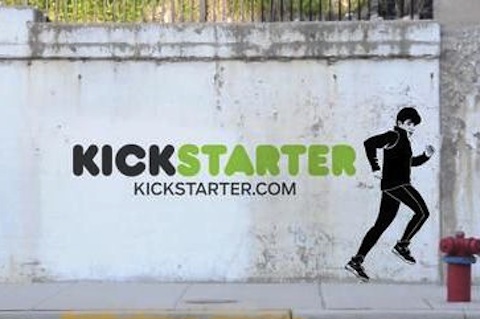 Last Friday we had the pleasure of welcoming Stephanie Pereira, Art Program Director for Kickstarter, a site that we have profiled, examined and analyzed a number of times here on the blog, to Carnegie Mellon for a speaker series event for our Master of Arts Management program. Her presentation and Q&A session talked about how projects are started, the rules for the site, and a look at some of the more interesting projects the site has seen as of late.
As a policy student, I am always fascinated by numbers and what trends are driving the dynamic changes we are seeing in the arts community. Before I go back to my usual beat of looking at how the worlds of art, technology and policy intersect, I wanted to pause this week and examine some of the statistics that were presented at Friday’s event, and what they say about the nature of giving in the art world.
Last Friday we had the pleasure of welcoming Stephanie Pereira, Art Program Director for Kickstarter, a site that we have profiled, examined and analyzed a number of times here on the blog, to Carnegie Mellon for a speaker series event for our Master of Arts Management program. Her presentation and Q&A session talked about how projects are started, the rules for the site, and a look at some of the more interesting projects the site has seen as of late.
As a policy student, I am always fascinated by numbers and what trends are driving the dynamic changes we are seeing in the arts community. Before I go back to my usual beat of looking at how the worlds of art, technology and policy intersect, I wanted to pause this week and examine some of the statistics that were presented at Friday’s event, and what they say about the nature of giving in the art world.
As anyone who is familiar with Kickstarter can tell you, their growth in recent years has been nothing short of astounding. I recently looked at how their estimated funding level for 2012 is set to eclipse the entire annual funding for the National Endowment for the Arts (NEA), a federally funded arts program. That kind of grassroots energy, passion and dollar commitment is a testament to a real market for substantive funding for art projects at the national level.
Why has it taken this long for large scale arts funding to reach the national stage? Technology would certainly be one answer, as the world of social media has opened up other industries to new funding mechanisms and audience participation. And while there are other excellent crowdfunding resources on the web, Kickstarter remains the most visible, offering artists the best potential opportunity to ultimately create their projects.
Anytime you have a site like Kickstarter that changes the way the arts are funded here in the U.S., a look behind the curtain at some of the statistics is a welcome way of analyzing what exactly is responsible for its success.
One important stat to point out about Kickstarter: while the recent projects that eclipsed the $1 million mark receive most of the attention, the vast majority of successful projects fall in the $1,000-$5,000 range. The rewards offered for these projects pale in comparison to those of the more ambitious projects, but having such a low threshold naturally entices more people to commit dollars in the hope that a project they admire and want to see is successful.
Another important stat to point out: the average pledge amount is not, as I would have expected, in the $10-20 range. According to Kickstarter, it is actually $71, which shows people who are pledging money to these projects are donating more than a couple cups of coffee: these are real dollars being committed here, and it is of little surprise that with the thousands of projects being featured on the main page of the site over any given week, that so much money is being pledged to the wide variety of projects on display.
Perhaps the most interesting statistic, however, is what Kickstarter refers to as the “tipping point” for project success: once a project reaches pledges totaling 30 percent of its funding goal, it has about a 90 percent chance of reaching its target. This puts a lot of pressure on artists and project leaders to get their main support system at the outset (i.e., their friends and family) to commit funds in an effort to pass that threshold. While not a guarantee, it is fascinating to see how often projects reach their end goals when they pass a common threshold.
Finally, it may surprise you to learn that the three categories that receive the most pledges do not include paintings, or public art pieces, or video games: the top three categories consist of film, music, and design (with film being the winner by a large margin; dozens of films are now being released each year that were funded through Kickstarter, with many of them debuting at SXSW a few weeks ago).
These are just a few of the hundreds of statistics that Kickstarter has provided over the years. Their blog is a great resource for a look at the trends and figures that help explain the quantitative success behind the site, and is definitely worth bookmarking.
We love writing about Kickstarter here at Tech in the Arts, and as the site continues to grow in future years and brings to life thousands of art projects, we can’t wait to see what kind of ideas and projects come our way.
The Year That Was
The clock’s ticking is becoming ever more pronounced, 2011 shall soon be placed in the archives of our collective history. So as we bid farewell to this year, let’s not forget the events that made the technology-art axis rotate for a full 365 days!
The year began with the unfolding of the Google Art Project, which revolutionized not only the way we view and how much we could view of an artwork, but also how art in museums became accessible at a global level.
And as art became accessible to a host of people, people became accessible to arts organizations through crowdsourcing. This year, we saw an incredible rise in the use of crowdsourcing, in many different areas and for many different purposes. Operas were crowdsourced, exhibitions were crowdsourced, and even art-works were crowdsourced. But it was the concept of crowdfunding that received a standing ovation from a crowd of people, organizations, and artists.
And in the pockets of these crowds of people were smart-phones and tablets, all glowing with the slide-to-unlock signs. With the rise of the iPhone/Droid/Blackberry and the iPad, many museums developed apps for specific artists or exhibitions in order to augment and guide the viewing experience. In fact, apps revolutionized the way audiences interact with art and museums were quick to capitalize on this opportunity.
Moreover, some galleries and museums relocated to the online world, and entire exhibitions moved from the realm of the physical to that of the virtual. Paddle8 and Art Micro-Patronage were both introduced this year, and only time will tell whether online exhibition spaces can be just as successful as offline ones. Moreover, there was an increasing emphasis on tailoring the arts towards one’s aesthetic and visual interests through Art.sy and Artfinder, the Pandoras of the art world. Additionally, s[edition] rebelled against the procurement of tangible art forms through its effort to sell digital limited edition prints of big name artists such as Damien Hirst and Tracey Emin.
As always, social media analytics remained at the forefront, and arts organizations realized the importance of sharing and conversing with their audiences through social media platforms such as Twitter, Facebook, and Google+. Many studies were done on Millenials and their motivations, which helped organizations engage and connect with this tech-savvy generation.
And as conversations became heated in social platforms, the world of art and technology did not let us forget that Earth itself is experiencing global warming. There were some excellent fusions of art and technology aimed at the problem of climate change and the move towards green energy by organizations such as GlacierWorks and SolarFlora.
But what will the year 2012 bring in the technology-arts realm? Innovation, progress, the unexpected, awe , wonder, but surely not an apocalypse, right?
Happy New Year!
Crowdsourcing Creativity
Social Media Spotlight: Crowdsourcing Archives with Richard McCoy
Welcome to the sixth installment of the Social Media Spotlight, our monthly feature focusing on arts organizations’ social media strategies.
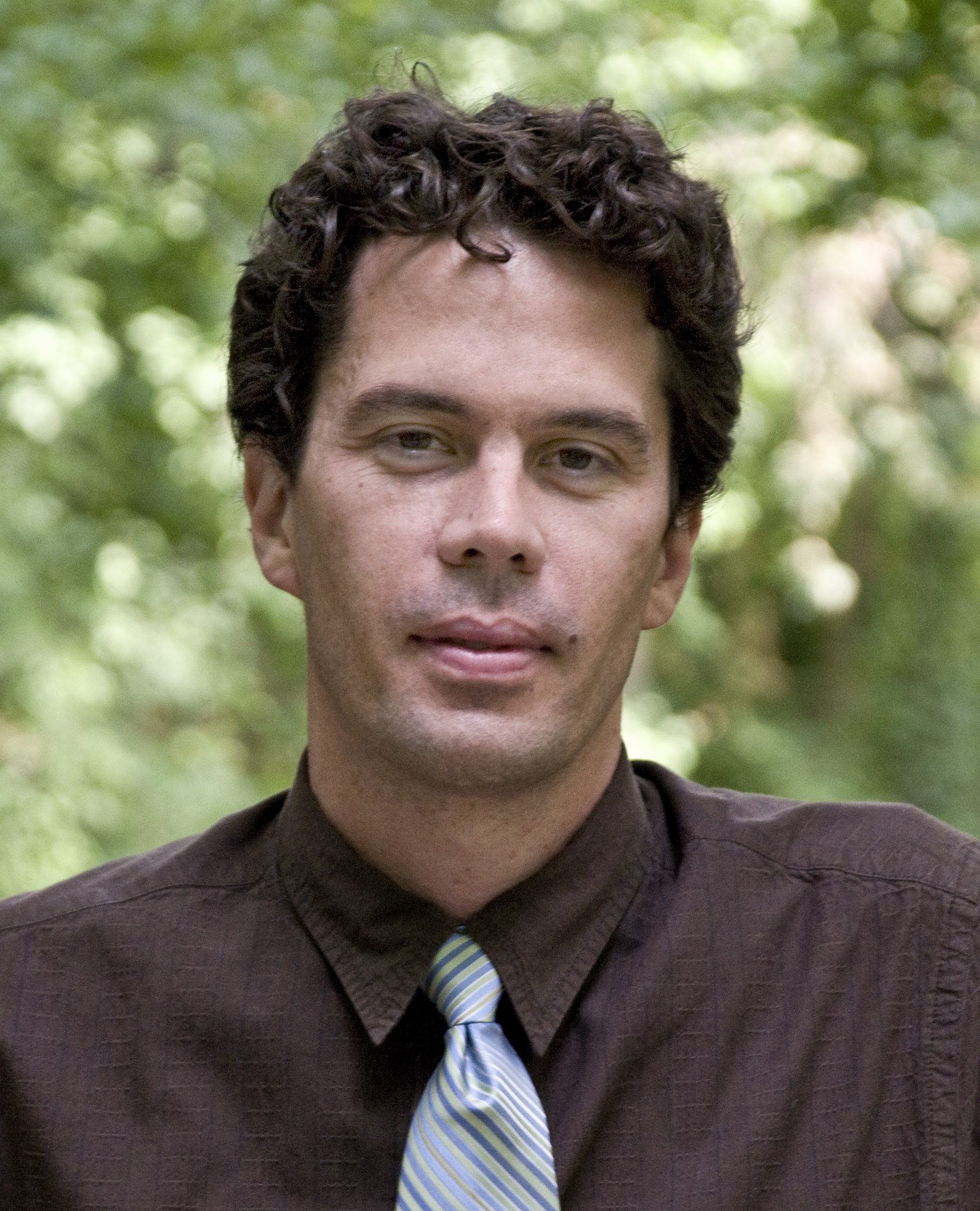 Making the arts a more participatory experience is an exciting idea being developed by many arts organizations across the globe. Visitors to some institutions can now digitally tag artwork with their own unique descriptions or add photos of themselves to a community Flickr pool. Taking the role of participation even further, some organizations are turning to crowdsourcing, inviting the audience to help in the creation and documentation of art.
Making the arts a more participatory experience is an exciting idea being developed by many arts organizations across the globe. Visitors to some institutions can now digitally tag artwork with their own unique descriptions or add photos of themselves to a community Flickr pool. Taking the role of participation even further, some organizations are turning to crowdsourcing, inviting the audience to help in the creation and documentation of art.
I recently had a chance to chat with Richard McCoy, Associate Conservator of Objects & Variable Art at the Indianapolis Museum of Art, about his use of crowdsourcing and public access tools to get the public involved in documenting public art.
I
How did you get interested in documenting artwork online?
By 2008 basic versions of all of the tools that cultural institutions use to create, store, and share documentation about their artworks were freely available online (Wikipedia, Flickr, and YouTube), so I’d say my interest really got serious around this time. I know it’s a bit nerdy, but I keep a pretty good record of my interests in documenting artworks online over on my Wikipedia User Page. My basic thought was why not do it? The investment is low and the potential for return is enormous.
I
Why involve the public in the process?
To properly care for an artwork you have to care about an artwork; you have to recognize its existence within your community. Many public artworks on display around the world are overlooked, their context and meaning forgotten on daily basis. So to have the public involved is an important aspect of this project. The more people that are involved in caring about and for public art and helping to document it, the better.
I think Clay Shirky has done a good job over the years explaining how the participatory web is radically different from our traditional notion of information sharing and collaboration. His 2005 Ted Talk is still ahead of its time. I agree with him in that we are just waking up to the notion of a large-scale participatory process that involves broad audiences using their “cognitive surplus” productively.
My interest has been more in community than public, though. Documenting public art should be a community effort. While it’s not the easiest thing to do, it’s a process that we have taught and developed with more than 40 IUPUI students.
We’re at a point where we can begin seeing that this is a project that should be operating on a global scale. Right now there could be folks documenting a mural in L.A. and a small town in India.
I
Where did the choice to use wikipedia as a teaching tool come from?
I first started using Wikipedia as a teaching tool in the fall of 2009 when professor Jennifer Mikulay invited me to co-teach an IUPUI Museum Studies Program graduate-level course, Collections Care and Management.
We created a project for our class to document all of artworks on and around IUPUI’s campus. That semester our students created 42 new Wikipedia articles and uploaded 375 new images of the IUPUI artworks into Flickr. The result culminated in the creation of the IUPUI Public Art Collection and the beginning of WikiProject Public Art, which was first called Wikipedia Saves Public Art.
This year I taught the course by myself. I used WikiProject Public Art as a final project to document the artworks inside and around in the Indiana State House. My students made 37 new Wikipedia articles and uploaded 272 images into Flickr. We did all of the work within the confines of Wikipedia. My hope was to model a project that could and should be repeated all over the country.
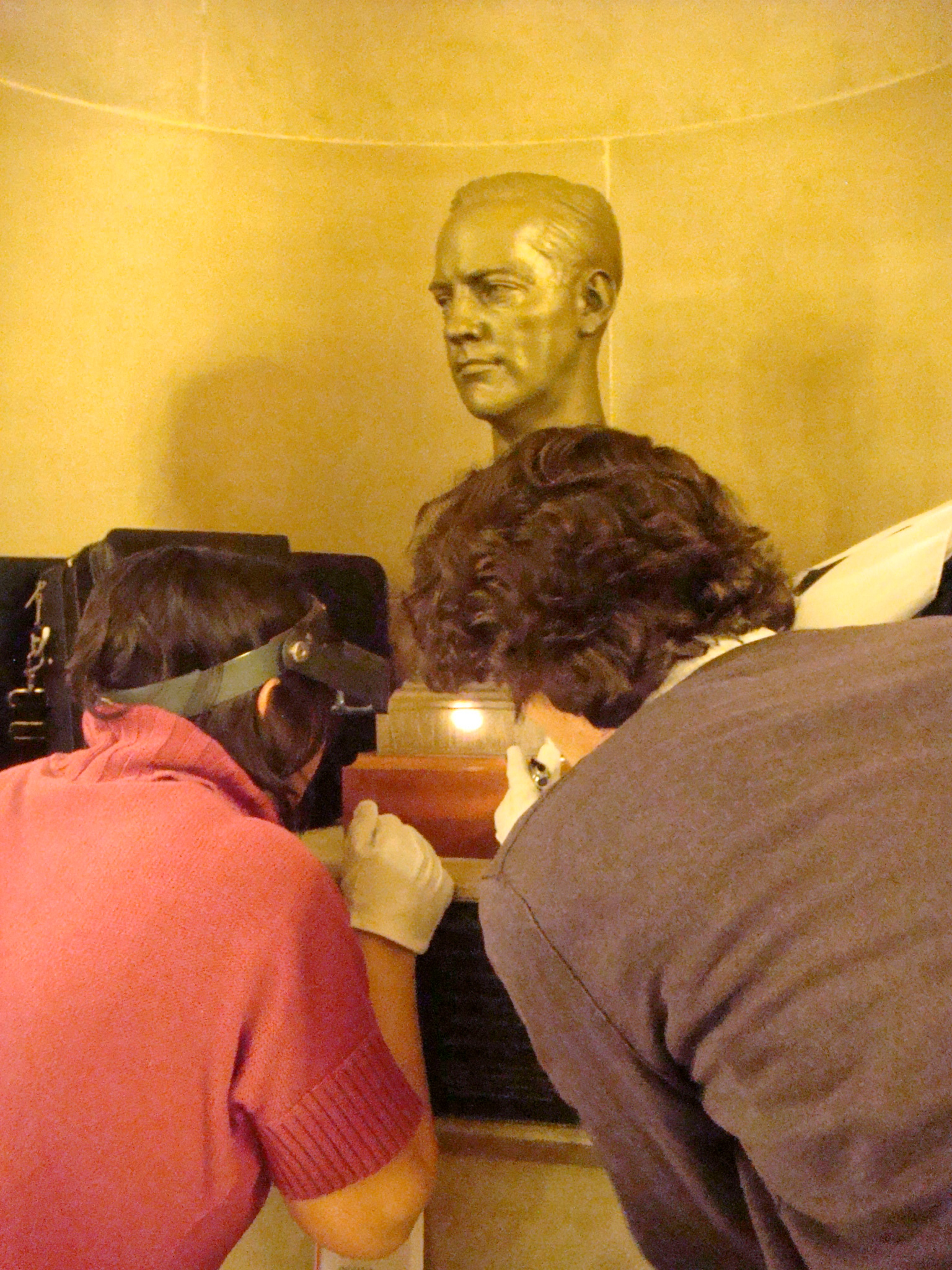
In addition to creating the Indiana State House Public Art Collection, I assembled all of the articles into in an easy-to-download book. I wrote a summary of all of this documentation work in the article New Systems for Documenting Public Art on Liam Wyatt’s blog.
I
I understand you and the class were recently recognized by the State of Indiana for this work. What was that like?
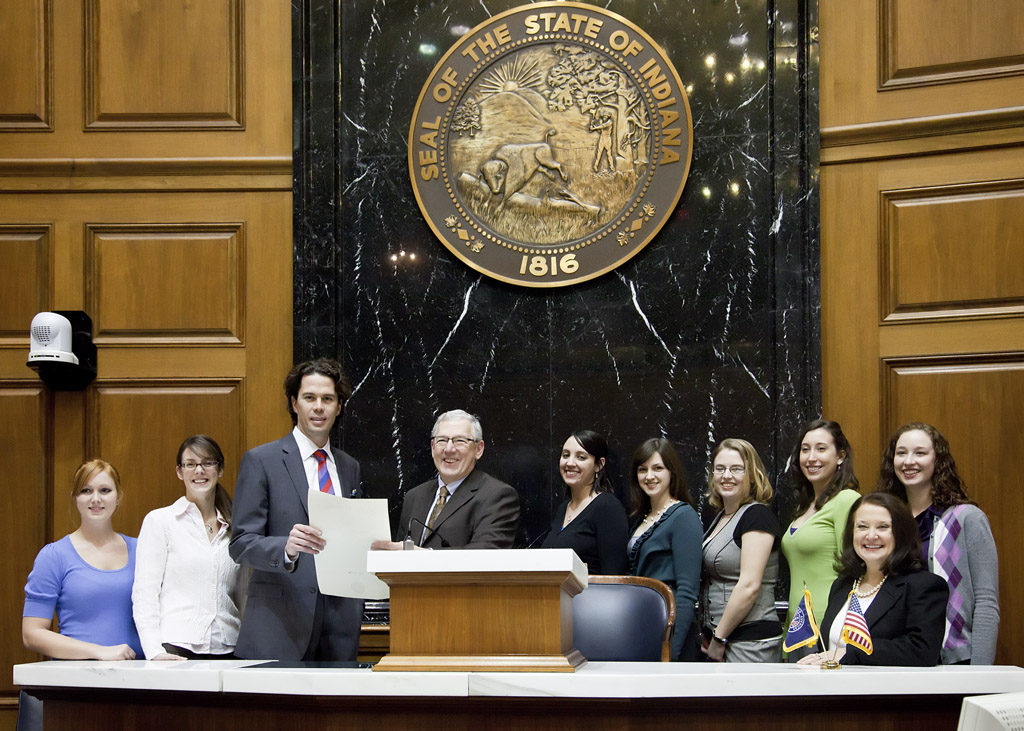
We were tremendously honored to have both the House of Representatives and the Senate of the State of Indiana recognize our work with Concurrent Resolutions. I’m most pleased about this recognition because it furthers the mission of the project: to raise awareness about the artworks at the Indiana Statehouse.
While this recognition can be personally gratifying, the project is designed with the hope that the students will take ownership of it and its outcomes, as they are the ones who did the lion’s share of the documentation.
I
Can you talk about the Public Art Documenter Project? How does it work and what are your goals for the project?
For a long time, I’ve wanted a mobile app that would allow for the easy documentation of public art. The most basic component of any kind of documentation involved three components: location, photography, and the basic tombstone information about an artwork. This would seem fairly easy to do with a mobile app.
Image via appbrain.com
When I found the mobile app creator, EpiCollect, which was developed at the Imperial College London, I was pretty excited. With this tool I was able to quickly make the Public Art Documenter. There are some down sides to this app, mainly in that it was developed with Google Apps, so it works really well on Droid phones, but not so well on the iPhone. It’s also pretty tech-heavy, so it’s not all that easy to use. I’ve been in conversation with the folks at Imperial College London who are in the process of creating the next version of this app which apparently will improve a lot of the iPhone bugs.
Also, with a number of friends, I’ve experimented with the potential for location-based applications such as Gowalla and Foursquare to serve this function. With Gowalla, I’ve made a couple of “Trips” including the “Top 10 Public Artworks in Indianapolis” (http://gowalla.com/trips/557).
I
I
I
Was there a specific reason you chose not to go through process of building an app of your own?
We’re really in an experimental stage with a mobile app. We’ve considered applying for grants to develop and expand the project, including creating a mobile app. But more than money, what the project really needs is a few institutional partners that are interested in using current technologies to document public art, or artworks in general. While we’ve explored this with what would appear to be a few natural partners, including the Smithsonian Institution, who holds the archives for the important project Save Outdoor Sculpture!, we’ve yet to get anyone to directly support any aspect of the prospect.
I
Crowd-sourcing archives is an exciting idea, but I can see some people arguing that it cannot compare to traditional documentation methods. How do you view your projects fitting in with current and past archival and documentation techniques?
This is a really interesting point to consider, and it goes not only to the storage of information, but the ownership of information and data. When you work in Wikipedia you are applying a Creative Commons license to the information you create. Also you are working collaboratively with a shared goal in a system that can be updated instantly by anyone in the world. Because the information is built with this structure, it’s then actually owned by everyone and really no one. This is a fantastic notion to consider vis-a-vis traditional documentation and sharing methods.
For example, compare our project to Philadelphia’s MuralFarm.org, Indianapolis’ Public Art Locator, or the Save Outdoor Sculpture! data. While this is all good data and information about public art, it’s stuck behind a website that is controlled by a very small handful of people. All of these systems were designed to increase access to information about public art, but none are able to offer the kind of inclusion that’s possible with Wikipedia.
Plus in using Wikipedia you are actually invited to download the whole data set and keep it for yourself. In fact, the information is licensed such that if you wanted to, you could use their book creator tool (the one I used to make the book about the Indiana State House Public Art Collection), create a book and then sell it for a profit, or just print it and have it on hand. This is what the State House did with our information, so now they have the most complete records of their artworks in the more than 100 year history of the State House.
I
Your projects all focus on primarily documenting public art, do you see these ideas and methods working well for other areas of the arts?
Of course! I recently had an intern working for me at the museum that developed an e-volunteer program that invites people to create Wikipedia articles about artworks in cultural instituions. While we have a pilot underway at the IMA, we hope that other cultural institutions follow suit and invite their patrons to help document their collections.
Not only do many institutions lack the resources to basically document their collections, but few have recognized the value of incorporating a participatory audiences in the process.
The lack of cultural institutions with decently documented collections was famously spelled out in the Heritage Health Index Results, and reinforced in the 2009 Salzburg Global Seminar, “Connecting to the World’s Collections: Making the Case for Conservation and Preservation of our Cultural Heritage”, but few have recognized the need to open the doors and encourage a broad spectrum of participation.
Opera by You: How to crowdsource a production
By this point we’ve all heard about crowdsourcing. It's a way to outsource a project and let a large group of people create it online. (See video at the end of the post for a fuller explanation, complete with animated fish.) We’ve heard about crowdsourcing logo designs, requests for proposals (RFP's) or even determining which paintings to show in an exhibition. But how about an full-length opera? Well, one company is crazy enough to try it.
The Savonlinna Festival in Finland has been developing an opera through the collaboration platform wreckamovie since 2010. The Opera by You initiative has been developed in five phases, some of which overlap. First, the crowd collaborated on a plot and name for the opera in July 2010. They decided on the title Free Will and the following plot, as described by Paivi Salmi, Project Manager of Opera by You:
God has had enough of all the misery that people are suffering from and calls a meeting with the angels. They decide to send a few dead geniuses back to Earth to make things better. They are supposed to make a huge difference in science and art and create world peace. The geniuses are Joan of Arc, Oscar Wilde and Wolfgang Amadeus Mozart.
Second, writers began work on the libretto (or script) to the opera. The process is halfway completed and is set to be done in May. Third, the composers in the group began setting the words to music in September. Fourth, the project coordinators launched the visualization plan. Salmi described the process.
Visualization means to us creating the concept of “environment” on the stage: the era of the opera, stage sets, wardrobe, lightning etc. We have decided together with the community that the story of Free Will will take place in our modern time and now we proceed on deciding how the different scenes look like visually.
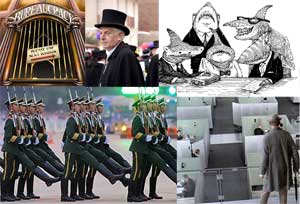
- Visualizations of Hell in the year 2012 from Opera by You
The libretto, composing and visualization plans are set to be ready at the end of May 2011. In the last phase, the whole concept will be moved to the hands of the Savonlinna Opera Festival for production, and that is where the crowdsourcing will end when it comes to the live opera production. The opera will be produced during Savonlinna’s 2012 summer festival season. The crowdsourcing will continue in that the existing community within the wreckamovie platform will work with the current plot, creating an animated movie version of the live opera. To see the opera creation in action, visit http://operabyyou.wreckamovie.com.
Paivi Salmi manages the web community creation process as well as the marketing and community partnership initiatives. I caught up with Salmi and asked her about the collaborative process of crowdsourcing the opera.
How did this idea originally come about? The Savonlinna Opera Festival has been frontrunner in developing opera genre in Finland. We have had several projects for instance for creating operas for kids. This spring we will again launch this kind of project where kids create opera as part of their normal school work. The Savonlinna Opera Festival has had several Finnish world premieres with quite unusual productions. We are actively searching new ways of reaching new audiences for the opera and also new ways of creating the opera. So in the spirit of “Web 2.0,” we decided to try the collaborative product development or crowdsourcing in the web also in the field of the opera.
How did you choose wreckamovie as the platform to create the opera? The wreckamovie platform provides the basic tools for collaborative discussion and working. It is also well-known in the Europe at least and already has lots of members interested in collaborative working on the web. We also plan to create an animated movie about the plot of our opera and for that second phase of the project, wreckamovie will the best available tool.
With so many people collaborating on one project, how do you select the best ideas? How do you deal with differing opinions on the direction the project should take? We have five operatives in the team who are experienced opera creation professionals (a script writer, a stage director, a composer, a production specialist and a visualization expert) who will guide the creative process in the web. Their task is to select best ideas, give the "developing” tasks for the community.
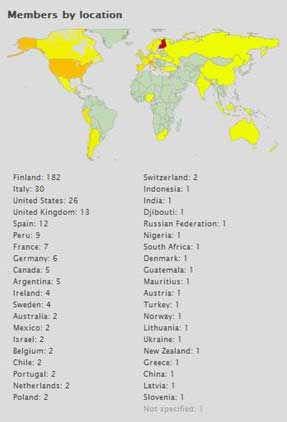
- Opera by You Community Members by Country.
Who are the people collaborating on the project? Do you know the make-up as far as country, age, and profession? Do most have an artistic background and collaborate on areas of the project they specialize in? When it comes to age, they are average 35 years old, mostly motivated by composing and visualizing. We don't collect any information about their profession or education, so we do not know if they already are professionals in the field of opera or classical music.
How do you plan to distribute the opera once it is produced at the festival in 2012? Will the footage be available online, recorded or streaming? The opera will be performed 3 times during summer 2012 in the Savonlinna Opera Festival. If some opera house is interested in the project, we will naturally export the production. We plan to make footage available and also animated movie which will be distributed online. The project was launched at the Opera America annual meeting in L.A. last June.
How are you addressing intellectual property issues for the contributors to the project? Every member has to sign user agreement and accept Wreckamovies terms of use where the member gives all rights to the project. So there will be no intellectual property issues.
What has been the response from the online community and the opera community at large? The community has been growing steadily, but only certain members are active in all "production lines". It goes so that some are writers, some others composers and some only interested in the visualization part. But mainly people are very excited and willing to work "for free". We also want make it easy to just anyone without any classical music or opera experience to participate to the collaborative work. We have reached a very good visibility to our project in the internet. For instance in the launch phase of the project there were lots of articles in online media for instance in Latin America, India and Europe. The larger opera community has been very interested and curious. We have been asked to present the project in several conferences and seminars. People are also very interested in the process itself--how has it been ”structured” etc. within opera community but also in the larger community of art, theatre and even social media.
Here's a more detailed answer to the question "What is crowdsourcing?"
We Have A Castle, Write Us An Opera!
Every good castle needs an opera company, or so the Savonlinna Opera Festival of Finland would lead you to believe. They have been performing at St. Olaf’s Castle in Savolinna, Finland since 1912. The festival took a 50-year Hyades between 1917 and 1967, but since its re-inception in the 60’s has been known for its cutting edge works and operatic premiers. Starting in their 2010 season they have decided to push the envelope of innovation even further. The Savolinna Opera Festival is crowdsourcing an opera for its 2012 season through a new project: Opera By You 2012
They are asking the public to write an opera from beginning to end for their 2012 season. They want the world to create everything from the story, set design and costume design to the music and libretto. Savolinna is providing the performers, the crew, and an orchestra; the public is providing the opera.
To my knowledge this has never been done before in Opera and certainly not to this extent. The Savolinna Opera Festival is taking advantage of wreckamovie.com to host their crowdsourcing forum. The site was originally set up for crowdsourcing movies, but also seems to be working well for opera. The only major problem I could find was the lack of music sharing technology on the site. It is still not clear how the composers will collaborate on the score for the opera.
Currently, members are working on the plot synopsis for the opera within the online forum. There are ideas ranging from aliens to sea monsters and insurance salesman to princesses, a true amalgamation of creativity. The opera is still in its early stages of creation and nothing has been set in stone yet.
I was a little frustrated that I could not find any information on how they are going to decide which ideas to use. It is not clear from the website if the management is making those decisions or if the public is going to vote. I am personally a fan of putting as much ownership on the collaborators and public creators as possible. The idea that an opera company would forgo control and perform whatever the public wants to see is very exciting.
Opera By You 2012 has the potential to change the world of opera and set a new benchmark for the use of technology in the ‘high arts’. This project is breaking many of the stereotypes typically associated with this art form and opening opera to a much wider audience. Opera By You 2012 is not about tradition or ‘the classics’, it is about making new art and opening up an opportunity for the masses to interact with opera.
Technology is helping this arts organization reach out to the world and break down some of the barriers that keep many people away from the classical music realm. Crowdsourcing taps the collective creativity of everyone involved and creates a product that is not only designed for an audience, but by them. This type of innovation is what keeps the arts current in our society. It will be very interesting to see how this opera materializes and the impacts that it will have on the world of opera.







